got a big commercial form coming up…
I was on site today but forgot to bring my camera , but I’ll get photos next time.
My question is: got to form a wall about 30′ high 8″ thick up against an existing wall ( the flat way) – one of many walls but that is thr bigest …well tallest anyway. what ways do you guys know to tie the form. in the past on one job, I have used ready rod expoxied into the existing concrete on a small form that was conceal later.
what about breaking the cone off one end of a snap tie , then epoxy that end into concrete same like ready rod.
Guy I will be working with says there is some sort of method where you lay ply against wall then use a special tie that ties onto the inner ply, then ties onto the outer form, anyone hear of this?
also what other aproaches are there?
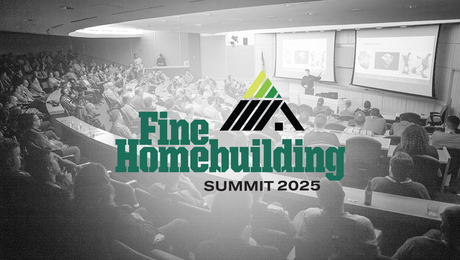
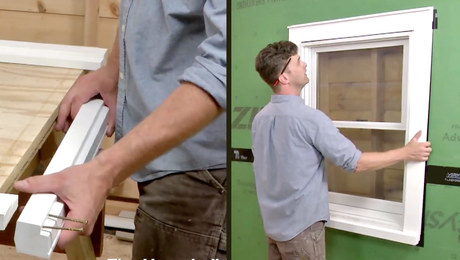
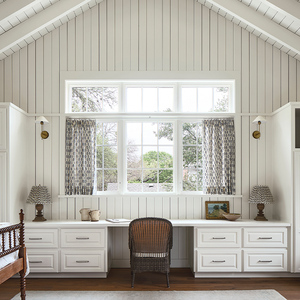
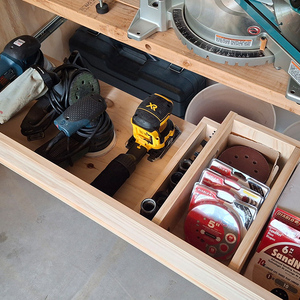
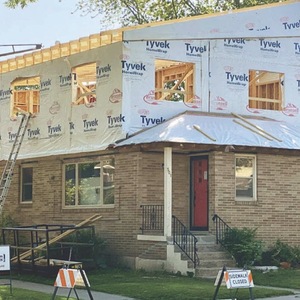
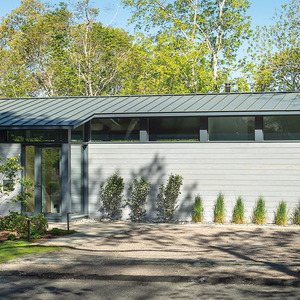













Replies
I've seen the ties they are shaped like... !__! ...like a three sided box. the two ends are just like normal snap ties but they are conected by a section that runs the length of your tie spacing.
Just curious - how do you go about getting concrete to the bottom of a 30' form?
Ron
gravity and a drop hose..
fill the form from the bottom... add the CC like a water hose put at the bottom of a 5 gallon bucket....
Life is not a journey to the grave with the intention of arriving safely in a pretty and well preserved body, but rather to skid in broadside, thoroughly used up, totally worn out, and loudly proclaiming<!----><!----><!---->
WOW!!! What a Ride!<!----><!---->
Forget the primal scream, just ROAR!!!
Gravity?
<G> Which I didn't exhibit, sorry. You asked a good question.
Saw the result of a from-the-top 30' ICF pour here. Wasn't pretty. Daylight coming through in lots of places. And with ICFs, no telling how bad was bad. Probably all those voids are what saved the ICFs from major blowouts. Archy owner/builder. Apparently the BI didn't complain. Archy thought it was funny.
Pour pockets are used to place concrete when you have high lifts. Button up the pockets when you go higher. Vibrating gets interesting.
I'm told it works well to hang the pumper tube down inside the wall. Tricky with an 8" wall if it has any rebar.
One thing for sure, you wouldn't find me on top of a 30' form with a vibrator long enough to reach the bottom. We normally only go 8' up at a time and 16' is tall enough for my houses.
Hope there are pix coming.PAHS Designer/Builder- Bury it!
What I was thinking is that there is going to be so much form tie and reinforcing down there that there would be no way to get a hose to the bottom of the form. For the same reason, you can't drop the concrete in. It would be nothing but honeycomb.
If you pump into access holes nearer the bottom, will that increase the hydrostatic pressure locally? I suppose you can vibrate it externally but it would still be hard to know what you were accomplishing way down there. When you're running a vibrator, you need to know when to quit.
Pics, for sure.
Ron
ok ..got a few pics...could only get decent shots of the tall wall...was near there on weekend and was all locked up ....the smaller wall,same idea , but up against block wall is underneath, in far back, can't really see it in pic.
The tall wall goes inbetween the 2 columns and meets the beam up at top, and will get tied into those 2 sections. The smaller wall that you can't see will be same idea but it is up against block instead of CC
View Image
IIRC, this is a seismic retrofit?
Pour 2 13' lifts, and fill in the top 4' with block, parged to match.SamT
"IIRC, this is a seismic retrofit?"
yes it is
Wow, better you than me. I see a lot that can go wrong placing the concrete and keeping the rebar in place.
Quite certain I'd decline the opportunity. SamT's method makes sense, except seismically. But I'd leave that to the engineer. A lot of CYA imminent.
Good luck.PAHS Designer/Builder- Bury it!
hee hee...I don't have to worry bout placing it...just forming it.
guy who asked me for help is a CC guy.. has does lots of small forms. he will be pouring it.
But he knew I had more forming experience than him, so he asked if I could lend a hand.
I don't have to worry bout placing it...just forming it.
I retract my retreat. LOL
You're covered. I hope he does a good job of CYA. This project doesn't pass the smell test yet.
Sounds like you're gonna have fun. If you do leave ply between the walls, T nuts with threaded rod (or snap ties) would be a simple solution.
Please post if you ever learn what the engineer's thinking is. I'm baffled.PAHS Designer/Builder- Bury it!
will do..I've only had minimal discussions so far.
here is the solution to your problem
i am assuming that you are renting symons panels
adjustable loop ties:
http://www.steel-dog.com/LC_LoopCoilTies.html
http://www.steel-dog.com/PDF_files/LC6ApplicationSheet.pdf
carpenter in transition
I'm definatly not familar with symon panels...
But I like the look of those ties...I'll see if symons panels is something available around here.
edit : looks like they got a few numbers in my area.
not sure if they'd work on the block wall though?
Edited 10/11/2006 12:43 am ET by alrightythen
what kind of forms are you using ?
you don't have to use symons panels to use this product. there are other options like adjustable snap ties for plywood forms.
i just suggested symons since they are what we own and what is very popular here in PA.
not sure if they'd work on the block wall though?
what block wall ? i don't remember seeing this mentioned.
is the wall you will be attaching to block ?
i'm sure you could use one of the epoxy anchors successfully in block.
carpenter in transition
the main wall is CC.
in post 12 I metioned block wall..and in post 24 with the pics I alos mentioned it.
There is a smaller wall maybe somewhere around 15 - 20 feet in height about same width , but up against block.
in response to your next post...pics will come ..I'd brought my camera specifically to take some shots...then I went and forgot to take the photos...
Also....another problem is the wall goes up to the underside of the concrete deck above....so far the plan is to form up shy of the ceiling and then dry pack the rest.
any other ideas? when I'd done the basement wall few years ago the house was gutted so it was easy to simply cut holes in the floor plates above and pour thru them. nothing like that is going to happen here.
so far the plan is to form up shy of the ceiling and then dry pack the rest.
I've got a repair coming up like that. Vehicle knocked out a chunk of cast-in-place basement wall. I just bought the truck- no damage at all. Appears to be zero rebar, which is what I'd expect from the folks who did the wall. Insurance co. engineer was wishy-washy. Still waiting to learn if we're going down to the minimal footing or just a patch.
But the house in this case hasn't moved at all so we're mostly keeping rodents out. Definitely not my design.PAHS Designer/Builder- Bury it!
I've already told him we need to to do it in at least 2 stages ..possibly 3.
How about a block wall? Could you use tilt up panels?
it won't be block wall, and several reasons why not to do tilt up.
You're planning to leave the ply between the walls? Can't imagine. I'd be looking at single-sided forming. Then it's a matter of chosing your preferred method of fastening the tie into the existing wall.
PAHS Designer/Builder- Bury it!
apparently that's the idea...so it rots out.
I've done singled sided forms on a much smaller, scale. which is what I'm more familar with. once using ready rod and once in a basentment where we sinply braced the whole thing.
the 2 side method is apparenty one method suggested by the engineer.
PS...what's your prefered method to attach ties to wall? I'm pretty sure if I remember we used Hilti Hit.. would one of those epoxies be any stronger?Oh yeah...there is another smaller wall about close to 20' against "block" wall how would you tie into that? I think that may be one reason the other method was broght up.
Edited 10/6/2006 9:30 am ET by alrightythen
Edited 10/6/2006 9:32 am ET by alrightythen
apparently that's the idea...so it rots out.
And leaves a void? This is waaaay beyond me. 30' of 8" wall isn't much if/when you shake it. As in, what's going to hold it together? Obviously I'm not the engineer, or one at all. Sure hope you're going to be able to enlighten us. I would've expected they were going to tie those walls so securely together that they became monolithic.
My preferred method to attach ties to a wall is all the way through. That way you can sleeve a bolt. Obviously only works when the other side of the wall is available, which is presumably the case here? You're looking at something I've never contemplated.
We do 16' tall 8" walls without a lot of rebar, but it's not antiseismic. We did have a 4, epicenter not far away, and no visible damage. As I understand it, vibration causes the concrete to separate from the rebar in chunks. Necessitating steel to hold the concrete onto the reinforcing. Concrete in tension requires help.
Real interesting, what you're doing. Not to mention intersting site.
FWIW, my last house client wanted a 2 story underground. Went back to my engineer who freaked. I knew how to avoid the huge earth load on the buried wall, as did he. But he wasn't about to get involved with that process. Ended up with a single story, 15' of dirt against the back wall. 8" it isn't. Could never stuff that much rebar into 8". Retaining walls are a little different.PAHS Designer/Builder- Bury it!
yeah a void..not my idea...the engineers...
I'll try an fill in some more details later ( as well as get some more details). I have to look at the plans,as well If you keep posted I'll have some pics for monday night.
Get your concrete accessory supplier to engineer the form system, that's their business! I don't think you can do this in one lift either. The forces on a single sided form that high are beyond a typical snap tie system. You'll probably need engineered bracing too.
>apparently that's the idea...so it rots out. On residential work, by code we're not allowed to leave temp forms, or leave anything behind to rot. Are there subtleties/exceptions to this code that allow that?
really...I haven't come across that specifically in our local code ( it might be there).
however on numerous occasions, we've had forms inspected that have had "hidden" forms
one example is where stairs have been formed with plywood box underneath instead of fill. There are times when structural fill has been specified and other times where the strengh is soley in the stair design.
actually I even recall a whole front porch that got formed and poured that way....everything inspected and on the up and up..not a sublte issue that could slip by.
30' form? that's over 5,000 PSF pushing the form away from the existing wall. Without vibration!
I've done a lot of commercial concrete, but, I'ld get an engineer involved in that form. And, I'ld be expecting him to specify snapties 8"OC . . . or less, IF, snapties were used.
yeah there is an engineer. I'm trying to find out what has been specified...apparently only a couple options have been suggested.
And yeah that is alot PSI! one reason to do more than one pour. I can't fathom ties 8" oc... at least 2 stages for sure.
Edited 10/6/2006 9:51 am ET by alrightythen
Shotcrete !
Mike
Trust in God, but row away from the rocks.
hmmm you mean like what they use for swimming pools?
these walls are for earth quakes..the big one is coming and the Vanouver area is getting ready. does that stuff have the same structual values?
does that stuff have the same structual values?
Talk to Cloud.PAHS Designer/Builder- Bury it!
>does that stuff have the same structual values? >Talk to Cloud.:)Heck, shotcrete's just concrete. Engineer's should be able to calc the strength (ability to withstand whatever design forces are relevant to the client) for concrete and steel. 30' tall and flat? No opinion from me on that aspect, but a coupla comments on shotcrete. Once upon a time I saw mention that the force of the spray results in greater compaction and thus strength, but I discount that. From what I've been told, the greater amts of portland used to get the mud to slide through the hose/nozzle is what results in the higher compressive strengths. The typical shotcrete wall I've seen rates at well over 4000 psi (some tested at > 5k) and is demonstrably tougher than a typical pour (such as a slab) by the same crew from the same redimix company. Does that make the wall stronger? Well, that's an engineering question and depends on thicknesses, rebar, shape and other stuff beyond my scope.The other comment is that a building in Asheville did essentially what's being discussed here, only for a different reason. They excavated behind a building to build another one. They used shotcrete to strengthen the exposed wall. Probably 15' tall wall. Lots of rebar. Couldn't tell wall thickness or layering on drive-bys be/c after the first layer, they all look the same (we use depth gauges). A caution with layering is the layer bonding. On our stuff, there's an enclosed environ that stays seriously humid and dark till the next layer is added, so the conditions are good. Outside, with sun and wind, the layers can easily dry before more is added. Will defer to a structural engineer on which factors matter how much.Hope all is well with you in VA.
Heck, shotcrete's just concrete.
Outside, with sun and wind, the layers can easily dry before more is added.
Exactly. Not much like cast-in-place, which the OP and I understand.
Fall is fantastic here. 2 clients thinking thinshell. We'll see.PAHS Designer/Builder- Bury it!
>Exactly. Not much like cast-in-place, which the OP and I understand.Well, shotcrete is done on open foundation walls, such as the one in Asheville, and on retaining walls and tunnels all the time. I just don't know the methods they use to balance a proper cure with building up to the design thickness. Heck, covering with plastic would make a diff, but I don't know if that's what they did, or if they were satisfied with no extra measures at all. The heavy texture of the shotcrete does provide a substantial mechanical bond between layers. I just haven't explored its sufficiency for this application because I've not have the need in prior projects.
I am currently working on a high rise in S.F. which is in between two old brick buildings for the first 4 floors.
The contractor put styrofoam against the brick then rebar then they come in and shoot the crete (wet) on and float the exposed side.
As a matter of fact they shotcrete all the walls to the top. Form one side and shotcrete it. these are 12" shearwalls 16 stories up. The floors are poured in the standard way.
I am only a commercial framer/ drywaller so I don't know the lowdown of it all.
Try a google of shotcrete contractors in your area. Mike
Trust in God, but row away from the rocks.
thnks mike...really nice feedback...I'll get some photos soon
PS drop the "only" part....
without guys like you nothing would get done :)
Edited 10/6/2006 9:09 pm ET by alrightythen
we did exactly the same thing about 6 years ago.
we needed to pour a wall against another concrete wall. it varied in thickness from 8" down to 4". ours was only about 10' tall. it sounds like you are going to do yours in lifts, which is very wise.
we used our symons panels and used 1/4" allthread for ties. the allthread was epoxied into the existing concrete wall and was left long enough at waler locations to clamp the walers.
i considered using ready rod but i liked the adjustability of the nut on a threaded rod better than the ready rod clamps. i also liked the grab of the epoxy on the allthread better.
also considered using snap ties but found that the tie length projecting from the concrete wall was critical and would be hard to determine quickly at so many locations. especially if the exisiting concrete wall was not straight.
the whole thing went well. to cut the allthread after the wall was poured we used an angle grinder to trim the rod off just below the surface. this left a scar in the wall which was ulitmately rubbed.
carpenter in transition
I understand your question but I have no answer. The question does, however, bring up something that has bewildered me for a very long time. Some explanation, I have zero experience with snap ties, walers, spreaders, strongbacks or the taller walls that use them. I have wondered, to myself of course, how do you physically install form ties in walls that are say over three or four feet in height? On the shorter stem walls I've worked on it's not a problem but on walls that are 10 to 12 feet tall, ??? With the footing in place, the outside form is put up, and then comes all the steel and pipes etc that go inside the wall but then, how in the h--l do you install the snap ties with the inside form in the way of everything? I can understand how you might install the ties into the holes of the outside form before lifting the inside form into position but then how do you guide the ties into the holes of the inside form? All is a mystery to me. Even skinny laborers can't get in there to thread them into place. So, how is it done? I admit it, there are still a few mysteries in the world that I haven't yet figured out but I'm always willing to learn. We're all family here. I almost asked on the job site once but was too embarressed so I just kept my mouth shut.
well....
I've done a fair ammount of form work (residential) mostly house foundations, but also a fair ammount of retaining wall forms including some fairly complex radius forms.
There are a number of approaches. for your basic foundation around here we usually use form rentals. the panels come 2' wide and quick strip ties are used. panels that we get come up 10' high ( the bears are 10' x 40" panels for the intersections) It's not really that hard...ok it takes some work..the inside corners are the toughest.
basically with your ties in ...you stand up the panel...get the bottom ties thru the holes then work your way up...it is possible to do it alone but is ten times easier with 2 people..one guy lifts the panel and applies pressure whiel the other guy reaches in with his arm to feed the ties thru. w 2' panels it's not a big deal...the worst part is all teh cuts you get from the tie wire on your arms...I like to wear long sleaves.
little trick I came up with to makes it easier, is to slide a spreader in at the bottom of the footing, it helps keep the panel in place as you lift. and allows you to toenail thru the bottom plate into the panel ( lots of guys let the inside panel float at the bottom ie: only bottom kick plate on one side . it works fine for lots of guys but I don't like it)
also it is a pain if you have sloppy rebar guys who hang the bar too low and it pulls the ties too low ..you have to force the ties back up..( careful my buddy sliced his palm wide open on a quick strip tie reefing on one)
snap ties are same idea..but are usually used with full size sheet goods...which then gets a little trickier because of the 4' reach issue...2 guys pretty much a must..guy with long arms and long handled esting framing hammer can usually reach...I often will make up a stick with a hook on end to reach in and guide the tie to the hole. snap ties can also be a little more difficult to work with when buttening up because they are longer then quick strip ties.
The tallest house form I ever worked on had a massive section at 20' high. we used double waler system with sanp ties and 2 x 8 panels layed horizontally. That was a good approach as we could easliy reach down to feed the ties...actually we only had to reach down a foot as the layout was holes in the middle of the pannel and on the edges lengh wise. so as you set a panel in you feed in the middle row then simply pound the top row of ties into the plywood edge. then next panel rest right ontop.
These are just a couple of methods, I've done others...but very little commercial...no tilt up or high rise, also differents parts of U.S. and Canada have other methods I have seen but am not familar with.
how do you physically install form ties in walls that are say over three or four feet in height?
Assuming two man crew, 8' wide plywood forms;
Set Iron, set inside form section next to iron and temp tie to iron. Stab snapties thru iron into inside form. Drop clips on tie ends, slide ties into iron to limits of clips.
Set one end of outside form section close to ties, leaves lots of room to walk into wedge shaped space, insert first row of ties and place clip on end, push form into iron just enough to insert next row of ties. Repeat. Push outside section close and temp tie to iron.
Set inside form sections on line , perm brace, wale, plumb, etc to completion. Repeat for outside forms.
With three men, complete inside form, stab ties, put one man on top with hook-on-a-stick, one inside at stabbed end of tie, one pushing outside form section. If iron is in the way, it's usually easier to push the tie end down to the hole in the form than to pull it up. On top man coordinates evrybodys' moves.SamT